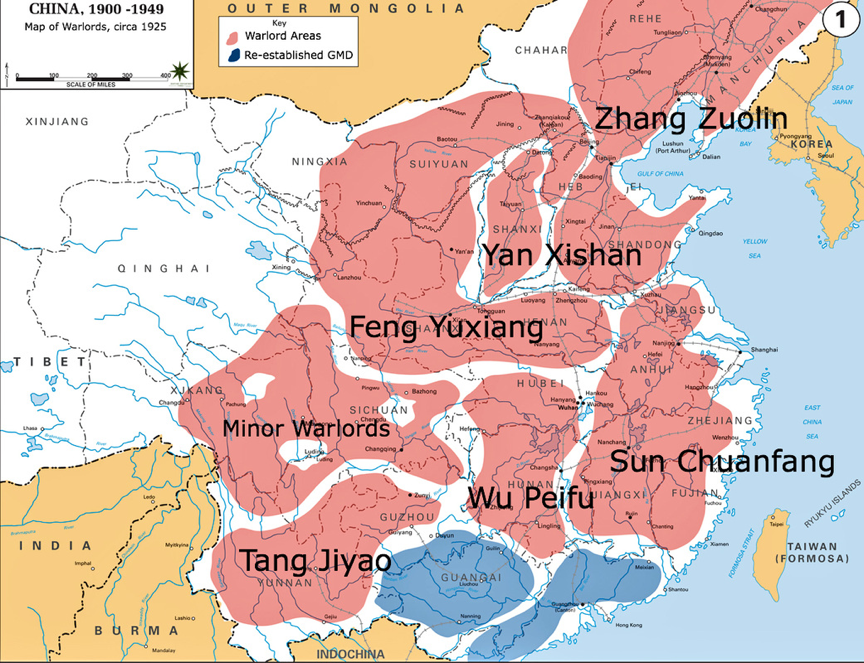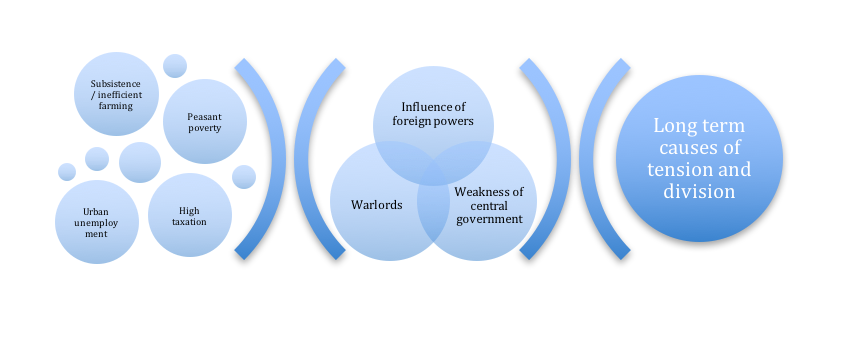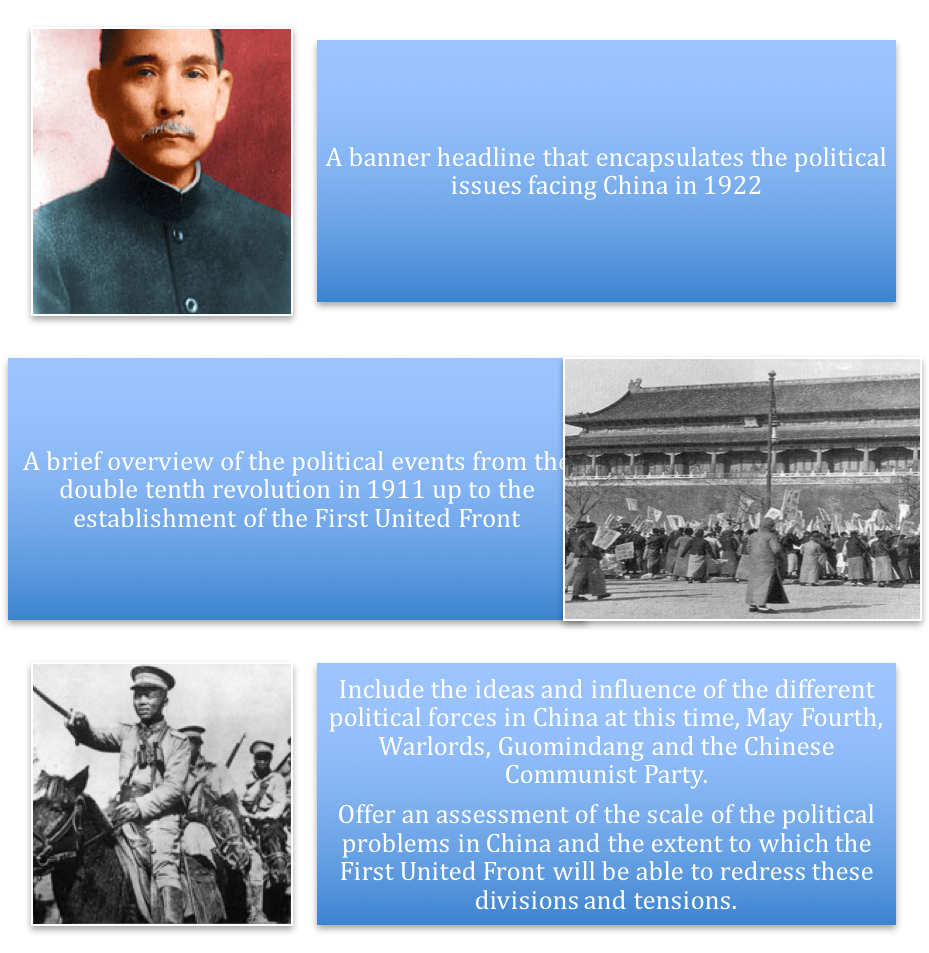1. Chinese Civil War: Causes (ATL)
.png)
The ATL on this page are designed to help students understand the causes of the Chinese Civil War
Essay writing practice for this case study as well as ideas for videos and how to incorporate these into your lessons can be found on the separate pages which you can see to the left
Note that this is a lot of overlap between this case study and Topic 12 for the Asian region Paper 3: Topic 12: China and Korea (1910 - 1950)
Guiding questions:
What were the long term causes of tension and division in China?
How was the ruling Manchu dynasty overthrown in China?
Why was the First United Front created?
ow did the First United Front attempt to unify China?
What were the short-term causes of the first phase of the Chinese Civil War?
What was the impact of the Sino-Japanese War 1937 – 1945 on the CCP and the GMD?
What were the short-term causes of the second phase of the Chinese Civil War?
1. What were the long term causes of tension and division in China?
Imperialist influence in China
Western imperialists had forced China to sign ‘unequal treaties’ that essential ceded control of certain areas to foreign powers, allowed them to trade at will and to station troops to protect their interests. The treaties had also granted these foreign powers the right of ‘extraterritoriality’ which means that their citizens were not held to account by Chinese laws and could operate under their own governments’ rules and legislation.
Starter activity
In pairs identify the countries that owned railway interested in China by 1900. Where in China are most of the railway interests?
Why do you think that the west and Japan wanted influence in China?
What does this foreign involvement suggest about the strengths and weaknesses of the Chinese central government?
The Warlords
Another problem for the central government in China were the Warlords. These quasi-military leaders had their own private armies and were the de facto rulers of large regions of China. The warlords ran the affairs of the territories under their control, would set and collect taxes and would often engage in small wars with other warlords for territory and booty. The central government lacked the means to control the warlords.
Task One
Thinking skills
In pairs look at the map below. Discuss the reasons why the warlords may have been able to establish control of large areas of China, and discuss what the central government could do to redress the regional power of these men.

Below is a summary of the economic and political problems facing China at this time; you may want to get students to research some of these points these in more detail.
Task Two
ATL: Thinking Skills

Click on the eye or download the PDF to see the economic problems and political tensions facing China by 1911
Create an infographic that clearly develops the links between economic problems, social unrest, political tensions and the impact of foreign influence in China up to 1911.
Economic problems
- The vast majority of the population were peasants. Farming was barely sufficient for subsistence and it was labor intensive.There was a lack of modernization.
- Peasants often faced starvation during floods or droughts
- Peasants bore the paid tax burden for the state, which included before 1991, the great Manchu imperial court.
- The population grew by 8% after 1850, but the land cultivated only increased by 1 per cent. This imbalance made famines more frequent.
- Peasants’ plots of land were reduced even though landlords increased rents
- Some peasants paid 80 per cent of their harvest in rent and taxes.
- Peasant poverty led many to migrate to the cities, but there was high urban unemployment due to improved industrial technology and cheap Western imports.
- Inflation weakened the financial position of the government.
- There was widespread corruption among local and provincial government officials which meant that a significant amount of tax revenues did not reach the central government.
Political tensions
- The European imperialist powers had humiliated and exploited China in the 19th century.This had destabilized China’s ruling Manchu regime.
- After China was defeated by Britain in the mid-19th Century in the Opium Wars the great Chinese Empire was carved up into ‘spheres of influence’ by the Europeans, Americans and by Japan.
- China had been forced to sign unequal treaties that gave the imperialist powers extraordinary controls over Chinese trade and territory.
- Missionaries flooded into China in an attempt to spread Christianity.
- There was widespread corruption in local government.
- The Taiping Rebellion, which raged from 1850 until 1864 spread throughout southern China, was only finally put down by the deployment of regional armies and with foreign assistance. Millions of Chinese were killed in the rebellion. The role played by regional armies signaled the beginning of the shift or power away from central government. After the fall of the Manchu in 1911, control became regionalized in a period known as the warlord of the 1920s.
- Some of the educated elite in China attempted to resist western influence. However, their ‘Self-Strengthening Movement’ was bitterly divided as to how to modernize China, and the Manchus did not meaningfully support reform.
- China lost more territory to foreign powers after it was defeated in a war with Japan in 1895. It suffered further humiliation and loss of territory in the settlement that concluded Japan’s victory in the Russo-Japanese War (1904–1905).
- There was widespread anti-foreign sentiment in China. This exploded in the Boxer Rebellion in 1899. However, without modern weaponry, this anti-foreign revolt was doomed to fail.
2. How was the ruling Manchu dynasty overthrown in China?
At the 20th Century, there was widespread feeling in China that the ruling Manchu dynasty had to be overthrown, democracy introduced and a program of modernization implemented. When the emperor died and was succeeded by a 2 year-old boy, Pu Yi, in 1908 the regime was further undermined.
The revolution began when the government lost control of the military; soldiers revolted and the uprising quickly spread. Several provinces then declared themselves independent of the central government in Beijing. This revolution in October 1911, became known as the Double Tenth. A republic was declared. The underlying tensions and divisions within China that had led to this revolution were also key causes of the civil war that broke out 15 years later. The Manchu dynasty had failed to address the weakness of its central government, the impact of imperialism, anti-foreign sentiment and ongoing economic problems.
In an attempted to seize the political initiative and to stabilize the situation, delegates from the newly ‘independent provinces’ met in In November 1911, in Nanjing. Delegates declared the Chinese Republic and Dr Sun Yixian, was chosen as China’s first president. However, Sun had been in exile in the US during the revolution and had no clear military backing for his presidency. To prevent a civil war from developing after the revolution Sun agreed for Yuan Shikai, leader of the northern army, to be president in February 1912. On 12 February 1912, Emperor Pu Yi abdicated. (For more detail on this see: 1. Rise of national identity in China (ATL) )
Task One
ATL: Thinking skills
What kind of problems do you think the new Chinese Republic would face? Discuss this question In pairs.
You should include the following in your discussion:

Task Two
ATL: research and communication skills
In pairs or small groups research the following:
- The Guomindang Nationalist Party and Sun Yixian’s Three Principles
- The rule of Yuan Shikai
- The warlords after 1916
- The May 4th Movement
- The formation of the Chinese Communist Party (CCP)
In each case, identify the impact on China
Note that all of the above are covered in detail with more specific ATL under Topic 12 for the Asian region, Paper 3 on this page: 1. Rise of national identity in China (ATL)
Task Three
Thinking and self-management skills
In pairs explore the key ideas and aims of Sun Yixian’s GMD and the founding ideas and aims of the Chinese Communist Party. You should collate your information in a Venn diagram that represents where the ideologies of each party were similar and where they were different.
.png)
3. Why was the First United Front created?
By 1922 two political groups, the Communists inspired by the Bolshevik revolution in Russia, and the Nationalists under the GMD inspired by the ideas of Sun had developed in China. Both parties were united in the aim of unifying China under a strong central government. Both parties understood that to do this they would have to take on the warlords. With these common goals the GMD and the CCP entered into an alliance in 1922, the First United Front.
Task One
ATL: Thinking and communication skills
In pairs write a ‘foreign correspondent’s’ report on the political situation in China in 1922. Your audience can be any country outside of China.
You should include in your article the following:
- A banner headline that encapsulates the political issues facing China in 1922
- A brief overview of the political events from the double tenth revolution in 1911 up to the establishment of the First United Front
- the ideas and influence of the different political forces in China at this time, May Fourth, Warlords, Guomindang and the Chinese Communist Party.
- An assessment of the scale of the political problems in China and the extent to which the First United Front will be able to redress these divisions and tensions.

4. What were the short-term causes of the first phase of the Chinese Civil War?
Sun died in 1925 and General Jiang Jieshi, a committed Nationalist, took over leadership of the GMD. Jiang was an anti-Communist; however he initially did not break the alliance with the Communists, as he needed the CCPs support to break warlord control. In 1926 the First United Front launched the ‘Northern Expedition’ to crush the warlords of central and northern China. This was a great success; by 1927, the GMD and the Communists had captured Hangzhou, Shanghai, and Nanjing. The First United Front took Beijing in 1928; the GMD announced that it was the legitimate government of China and the new capital and seat of government would be Nanjing.
Even though it had been successful in the Northern Expedition, the alliance between the GMD and CCP did not last. The differences in ideology between the two parties now came to the fore as the defeat of the warlords meant China could be unified. Jiang had been concerned that the success of the Northern Expedition had been not only due to the promotion of Nationalist aims, it was also due to the Communist promise of land to the peasants which had given the United front local peasant support. Indeed, the CCP had also had strong support from the industrial workers; the communist, Zhou Enlai, had organized the workers rising in Shanghai. Jiang decided that the GMD would not share power with the CCP. Jiang was more right wing than Sun, and was sympathetic to landlords and the middle classes. He was opposed to peasant attacks on landlords and land seizures that had occurred in areas under Communist control.
Jiang expelled all communists from the GMD. Then, in April 1927 he launched the ‘White Terror’ in Shanghai. Jiang, using informants from the underworld of triads and gangsters, killed 5,000 communists. The GMD was ordered to carry out similar attacks in other cities, in what became known as the ‘purification movement’. Estimates suggest around a quarter of a million people were killed. By the end of 1927 the CCP was almost destroyed.
The CCP decided that its only chance of survival was to flee to the mountains of Jiangxi. The GMD pursued them and was determined to wipe the CCP out. The first phase of the civil war had begun.
For more detail on the White Terror and the extermination campaigns carried out by the GMD against the CCP along with the Long March as the CCP fled for safety, refer to the information and ATL on the Paper 3 topic of China and Korea: 3. Rise of Communism in China (ATL)
Task One
Thinking and communication skills
Complete the grid which is attached on the PDF below. Add details, dates and key events as evidence. Discuss how / why these details are evidence of this factor causing tension and divisions in Chinese society.
![]() Grid activity on long and short term causes of Chinese Civil War
Grid activity on long and short term causes of Chinese Civil War
5. What was the impact of the Sino-Japanese War 1937 – 1945 on the CCP and the GMD?
The first phase of the civil war was interrupted by the outbreak of the Sino-Japanese War in 1937. To defeat the Japanese, incredibly, the GMD and CCP entered into another alliance, the Second United Front. This alliance held until Japan was defeated in 1945.
Task One
ATL – Research skills
Divide into groups of four. You will be researching the course of the Sino-Japanese War 1937-45.
Pair A Research the CCP during the war
Pair B Research the GMD during the war
Each pair should gather evidence on the following themes:
- How did the CCP or GMD fight the Japanese?
- How did the CCP or GMD manage the economies of the territories under its control?
- How far did the CCP or GMD gain political support in the areas under its control?
Feedback your research to your group. Compare and contrast the impact of the Sino-Japanese war, 1937-45 on the military, political and economic strengths of the CCP and the GMD.
7. What were the short-term causes of the second phase of the Chinese Civil War?
Another phase of civil war developed after 1945. This was because:
- The CCP was significantly strengthened, and the GMD was weakened after the long war with Japan. However, both sides believed it was able to win control of China on the battlefield and did not want to find a compromise.
- The polarization of international relations due to the development of the Cold War meant that China’s second phase of civil war would not be a purely domestic struggle alone. The war between Nationalists and Communists was now part of the wider struggle between the Soviets and the US to create a new post-war balance of power in Asia. However, both superpowers initially promoted the idea of a coalition government with representatives of both the GMD and the CCP.
- The US worked hard to achieve a diplomatic solution between the CCP and the GMD. US General Marshall proposed terms for a coalition government: form a temporary state council; unite both armies into a new national army; hold free elections for local government.
- Neither side wanted to share power. As negotiations were supposed to be finalized in February 1946, the GMD and CCP were moving troops into Manchuria.
- There would not be a diplomatic solution for China – its fate would be decided on the battlefield.
Task One
ATL: Thinking and research skills.
In pairs research the period of US led negotiation between 1944 and February 1946. You should attempt to find evidence of the following:
- US aims, investment and proposals
- Soviet aims, investment and proposals
- GMD engagement in negotiations and evidence of preparing for renewed civil war
- CCP engagement in negotiations and evidence of preparing for renewed civil war
After you have research the period of negotiations, discuss with your partner the extent to which it would have been possible to find a diplomatic solution for China after the Second World War. What were the key obstacles in the peace process?
Task Two
ATL: Thinking skills
The historian James Sheridan, in China in Disintegration (Free Press, 1977 p.269) argues that:
‘It is absurd to speak of an historical event as “inevitable”, but the Communist–Guomindang civil war almost demands that adjective. It is difficult in retrospect to see how it could have been avoided. An abyss of profound hostility and distrust, and the scars of brutal conflict, separated the two parties, to say nothing of their utterly different social philosophies’
In pairs discuss the extent to which you agree with Sheridan’s view of the situation in China in 1945.

 IB Docs (2) Team
IB Docs (2) Team
